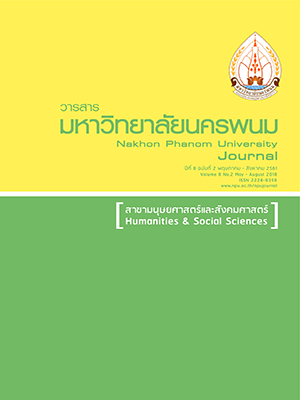ยุทธศาสตร์การดำรงชีพของครัวเรือนเกษตรกรผู้ผลิตผ้าทอย้อมคราม ในเขตอำเภอนาหว้า จังหวัดนครพนม
Main Article Content
Abstract
The purposes of this study were to investigate: 1) the development of livelihood among farmers’ households producing woven fabrics dyed with indigo, 2) the conditions affecting livelihood among farmers’ households producing woven fabrics dyed with indigo, and 3) the strategy for livelihood among farmers’ households producing woven fabrics dyed with indigo. The study employed qualitative research methodology. The area for study was Ban Non Sa-aad village, Na Ngua sub-district, Nawah district, Nakhon Phanom province. Data were collected from 20 farmers’ households producing woven fabrics dyed with indigo through semi-structured interviews, focus group discussion and observation. Descriptive analysis was used to analyze the data.
The study found the following. 1) Development of livelihood among farmers’ households who produced woven fabrics dyed with indigo was divided into 3 periods. 1. The period before the establishment of a group of farmers’ housewives. There was a production of indigo dyed fabrics for use in the households. 2. The period of establishing a community enterprise center. The silk and indigo-dyed fabric producers group was formed. The production process was changed to produce for export by receiving circulated support funds from the government. 3. The period at the current time. Households began to produce a wide range of products based on the investigation of market mechanisms. Some households switched to a product receiver in the community to sell to middlemen. Some households changed their role as a product distributor and began to use online social media for product public relations. 2) There were conditions affecting the livelihood of the farmers’ households who produced fabrics dyed with indigo, namely state policy, trends in capitalism, seasons/natural disasters, land tenure, and volatility of product prices. 3) Strategy for livelihood among farmers’ households who produce fabrics dyed with indigo includes skill in the acquisition of local wisdom, skill in creativity, skill in technique of production, and skill in study and learning. The strategy to adapt their families to survive is needed for having more income, having a better life, and having a stable career with no need to travel to work outside the area. It will, then, strengthen sustainability in the community based on knowledge and capability in the management of capital available.
Article Details
References
กีรติพร จูตะวิริยะ. (2559). ยุทธศาสตร์การดำรงชีพของเกษตรกรอีสาน : การผัน “ทุน” ในเครือข่ายเกษตรกรรมทางเลือก. ขบวนการประชาสังคมกับการพัฒนาในประเทศไทยและสปป.ลาว : พื้นที่สาธารณะ ทุนทางสังคม และประชาคม. 1(1), 75-200.
คณิตา ปะกิ่ง. (2559, 10 ตุลาคม). ปราชญ์ชาวบ้าน บ้านโนนสะอาด ตำบลนางัว อำเภอนาหว้า จังหวัดนครพนม, [สัมภาษณ์]
มณีมัย ทองอยู่. (2546). การเปลี่ยนแปลงเศรษฐกิจของชาวนาอีสานลุ่มน้ำพอง. กรุงเทพฯ : สำนักพิมพ์สร้างสรรค์จำกัด.
ราตรี อุสาพรหม. (2559, 10 ตุลาคม). ปราชญ์ชาวบ้าน บ้านโนนสะอาด ตำบลนางัว อำเภอนาหว้า จังหวัดนครพนม, [สัมภาษณ์]
สุชานารถ บุญเที่ยง. (2558). พระเกียรติคุณแผ่ไพศาลสายธารพระเมตตา. วิจิตรแพรวา มรดกภูมิปัญญาสู่ราชินีแห่งไหม. 1(1), 31-42.
อเนก นาคะบุตร. (2554). ทุนทางสังคมและประชาสังคมในเมืองไทย. กรุงเทพฯ : บริษัท 21 เซ็นจูรี่จํากัด.
อภิชัย พันธเสน. (2556). ทุนทางสังคม : มรดกเก่าจะนำเราไปรอดจริงหรือ. ขอนแก่น : คณะมนุษย์ศาสตร์และสังคมศาสตร์ มหาวิทยาลัยขอนแก่น.


